Chanoyu: Spirits of Winter and Spring
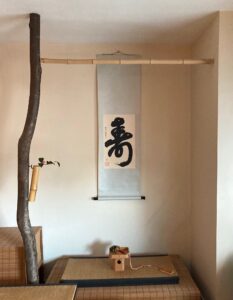
Ga-ran-dō, 伽蘭洞, Help-orchid-cave, tokonoma, kake-jiku, 掛軸, hang-thing, calligraphy, ‘Kotobuki’, 寿, Longevity, by Gu Jia Xin, dated Hinoe Tora, 丙寅, Fire’s elder brother Tiger, 1986. The Chinese hanging scroll was acquired blank for adding a painting, calligraphy, etc.
Kake-hana-ire, 掛花入, hang-flower-receptacle, take, 竹, bamboo, (with metal hanger), by Nishi-kawa Bai-gen, 西川楳玄, West-river ‘Prunus’-mystery, Taka-ga-mine, 鷹峯, Hawk’s Peak, Kyōto.
Ka-gura suzu, 神楽鈴, God-music bells, displayed on a san-bō, 三方, three-directions, Shintō offering stand.
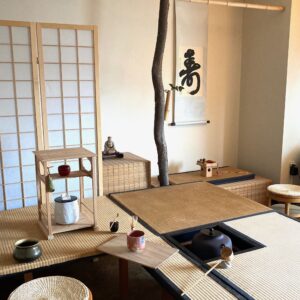
The year 2025 lunar Mi-doshi, 巳年, Snake-year, began on January 29.
According to Asian calendar, 2025, is a Mi-doshi, 巳年, Snake-year; one of the twelve animal signs of Asian zodiac. Each sign is identified with the influence of In and Yō, 陰 and陽, Yin and Yang, and the Go-gyō, 五行, Five-transitions, physical elements of Earth, Water, Fire, Metal, and Wood. Modified by these cycles, 2025 is deemed the year named Kinoto Mi, 乙巳, Wood’s Younger Snake. The Asian zodiac signs are also ascribed to month, day, and hour: Mi-no-tsuki, 巳の月, Snake’s-month, Mi-no-hi, 巳の日, Snake’s-day, and Mi-no-koku, 巳の刻, Snake’s-time, 9 to 11 am.
In the year 2025, the January 29th Lunar New Year observance is close to Setsu-bun, 節分, Season-divide, on February 2, which is the eve of Ri-sshun, 立春, Start-spring. Each of these occurrences are celebrated widely in Japan and are filled with happiness, good will, and vast symbolism. Traditionally, every Japanese person observes their own personal birthday age at the start of Risshun, rather than on the date that they were born. This has caused confusion, as people want to be as young as possible. In the traditional model, a baby born on New Year’s Eve becomes two years old on Risshun, February 3.
In Japan, spring begins halfway between the winter solstice, Tō-ji, 冬至, Winter-attain, the longest night of the year, in the northern hemisphere, on December 22, and the spring equinox, Shun-bun, 春分, Spring-divide.
According to legend, the sun was personified, or rather deified, as Ama-terasu Ō-kami, 天照大神, Heaven-brighten Great-god. Amaterasu is the daughter of I-za-na-mi-no-mikoto, 伊邪那美命, That-wicked-what-beauty-life, and I-za-na-gi-no-mikoto, 伊邪那岐尊, That-wicked-what-branch-noble, the primal couple of creation. Amaterasu was born from the left eye of Izanagi when he bathed in the Ama-no-kawa, 天の川, Heaven’s River, upon his return from the underworld where he went to rescue his wife, Izanami, after she gave birth to Fire and died.
From Izanagi’s right eye was born Tsuki-yomi no Mikoto, 月夜見尊, Moon-read-noble, who ruled the night, and from his nose was born Su-sa-no-o no Mikoto, 素戔鳴尊, Elementary-remain-cry-noble, who was given rule over the seas. Having been born from Izanagi’s nose, means that Susanoo has control of breathing, and human life could not exist without breathing. It is said that the Izumo Tai-sha, 出雲大社, Out-cloud Great-shrine, is the oldest shrine in Japan, even though I-se Jin-gū, 伊勢神宮, That-strength God-palace, is deemed the most celebrated, being dedicated to Amaterasu. Susanoo remains envious.
Susanoo had a violent nature, and cried and wailed constantly. Tiring of the sea, and envious of his sister Amaterasu, he destroyed the earthworks that separated her ricefields, he defiled her throne room, and threw the bloody hide of horse into her weaving room, prompting one of her ladies to stab herself with a spindle. It is curious that the drum head of the ko-tsuzumi, 小鼓, small-hand drum, are made from horsehide, which was played to coax Amaterasu out of the cave.
Outraged, Amaterasu concealed herself in the cave of heaven, and sealed the entrance with the Ame no Iwa-to, 天の岩戸, Heaven’s Rock-door, which no one could move. The world was plunged into darkness, and the eighty myriads of gods assembled and were unable to get Amaterasu to come out of the cave.
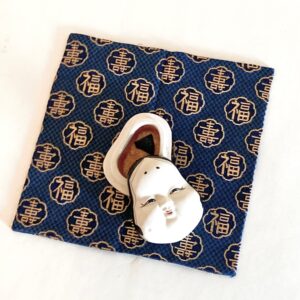
Kō-gō, 香合, incense-gather, ceramic covered container in the form of a mask of O-ta-fuku, お多福, O-much-fortune, Kyō-yaki, 京焼, Capital-fired; L. 2 sun kane-jaku. Otafuku is modelled after Uzu-me no Mikoto. Kōgō contains a small tetrahedron of neri-kō, 練香, knead-incense. Ko-buku-sa, 古帛紗, old-cloth-gauze, with design of ‘Fuku-ju’ kin-ran, 福寿金襴, Fortune-longevity gold-brocade.
The goddess of fertility, Ame no Uzu-me no Mikoto, 天細女命, Heaven’s Slender-woman-life, revealed her gender, chanted what became the Japanese ‘alphabet’, and danced on an overturned a sake barrel. Some sources claim the barrel was the origin of the drum. All the gods laughed. Curious, Amaterasu rolled back the stone, her bright rays illuminated the world, and Ta-jikara-o, 手力男, Hand-strength-male, held back the stone. This tale was an allegory on the change of seasons from winter to spring, called Setsu-bun, 節分, Season-divide. Less familiar is that the word ‘setsubun’ is used at each of the four seasonal changes of the year.
Amenouzume is known to have held something in her right hand which she used in an act of purification. In popular thought, she held a cluster of bells, suzu, which shook in all directions. However, in ancient times, there were no such devices. In one of Japan’s oldest writings, the Ni-hon-gi, 日本紀, Sun-rise (Japan) -record, it is written that Amenouzume held stalks of susuki, 薄, eulalia. Other sources suggest that she held a ta-gu-a, 手草, hand-grass, made of ko-sasa-ba, 小竹葉, small-bamboo-leaves, taken from Ama-no-ka-gu-yama, 天香久山, Heaven-scent-ever-mountain. Another had that she held a branch of sakaki, 榊, an evergreen plant sacred to Shintō, and that is related to tea. It is likely that susuki was selected, and may be the source of the word suzu for certain bells.
There are various meanings and interpretations of the name Uzume. One theory is that it implies ‘vortex’, the turning of the heavens, that seems apropos of the change of seasons. Another suggests tsuyoi, 強, strong, increase, which seems appropriate for a fertility deity.
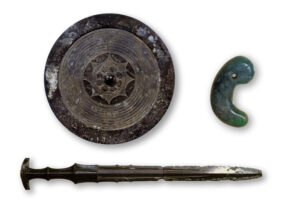
To appease Amaterasu, the gods presented her with many offerings; foremost of them was a mirror, a sword, and curved jewels. These three objects form Japan’s Imperial Regalia, the San-shin-gi, 三神器, Three-god-utensils: the Ya-ta-kagami, 八咫鏡, Eight-span-mirror, the Kusa-nagi-no-tsurugi, 草薙劍, Grass-mow down-sword, and Ya-saka-ni-no-magatama, 八尺瓊勾玉, Eight-span-beautiful jewel-bend-ball.
Because of his wild and destructive actions, Susanoo was banished to the region of Izumo, 出雲, Out-clouds. In his bravery, he slew a dread serpent that had eight heads and eight tails, and that was ravaging the area. It was named Ya-mata no O-rochi, 八岐大蛇, Eight-branch Great-snake. From the pieces of the serpent, swords were created. There is some truth to this aspect of the story and the serpent swords, as the river where the snake was slain, has iron particles that have been a source in metallurgy for centuries. The great shrine, Izumo Tai-sha, 出雲大社, Out-clouds Great-shrine, was built to revere Susanoo.
Susanoo’s sword, a type used by the gods, was called a tō-tsuka no tsurugi, 十拳剣, ten-fist-sword, which was the length of ten fists. An average fist is a breadth of about 3 sun kane-jaku, so that the length of the sword is about 30 sun kane-jaku or 3 shaku kane-jaku. The ten-fist sword might be identified with the ten pieces of charcoal used in the fires of both furo and ro.
The basic unit length of charcoal for Chanoyu is 2 sun. Most pieces are 2 sun, although some pieces are double the length and measure 4 sun. There is a major consideration in that there are two different measuring ‘rulers’: kane-jaku, 曲尺, bend-span, 3.03 cm, or approximately 12 inches, and kujira-jaku, 鯨尺, whale-span, which is 37.85 cm, or 14 ⅞”. The number of pieces of charcoal for furo is 8, two of which are double 2 sun, making a total of 10 pieces. The number of pieces of charcoal for the ro is 10. However, three pieces are double 2-sun totaling thirteen 2-sun lengths.

The gorgeous buri-buri kōgō has its origins in the New Year’s fire and is called a gi-tchō, 毬杖, ball-hit. It is used for the New Year tea presentation. Its length is 4 sun kujira-jaku. The dō-zumi, 胴炭, body-charcoal, that is burned in the ro fire is also 4 sun kujira-jaku. The charcoal pieces for a Tea presentation are cut into lengths of either 2 or 4 sun. Charcoal for the furo is measured with the kane-jaku, and the charcoal of the ro is measured with the kujira-jaku. Although the ro dōzumi is technically not a gitchō, it is the size of a true gitchō, which is present in the buri-buri kōgō.
The Kanji for gi-tchō are 毬 and杖. The Kanji, 毬, also read mō, is composed of ‘hair’ and ‘wish’, meaning ‘ball’, and 杖, jō, stick. The charcoal gitchō is likened to the head of a mallet used in an ancient game that is played like a cross between croquet and tennis without a net. The game was played by the aristocracy in the Heian period, and is continued to this day in reenactments. The original gitchō is the source of the ‘buri-buri’ kō-gō, ぶりぶり香合, ‘plump’ incense-gather, used in a New Year’s Chanoyu. The original ball was made of wood covered with leather or cloth. It is thought that the original ‘ball’ was a pine cone, and that the game was a metaphorical spreading of the pine seeds for future trees. The game, played in front of shrines during the New Year festivities, is called Matsu-no-uchi, 松の内, Pine-’s-in.
As the god of the sea, Susanoo also had powers over the wind and storms. Destroying the aze, 畦, levees, earth walls of Amaterasu’s tanbo, 田んぼ, rice fields, filled in the mizo, 溝, ditches, was probably accomplished by the fierce storms that ravaged Japan. It should be remembered that apparently destructive forces of nature must be appeased with offerings. A violent typhon is not by nature evil or intentionally a destroyer. Hence, great and small shrines are dedicated to all aspects of nature. Offerings of Chanoyu, Ken-cha-shiki, 献茶式, Offer-tea-rituals, are presented throughout Japan at shrines, temples, and other places of wors
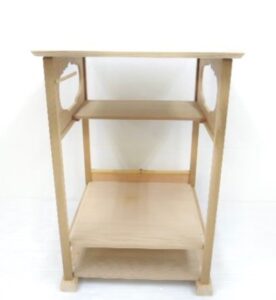
The Hakkei danacan be assembled to approximate eight different styles of display stand. Iguchi Kaisen was the younger brother of Tan-tan-sai, 淡々斎, Fleeting-abstain, XIV Iemoto, Urasenke. In the photograph at the top, of the Tea presentation in Garandō, the Hakkei dana is assembled to function like the sugi dana, 杉棚, cedar shelf. The middle shelf is slid back to gain access to the mizusashi.
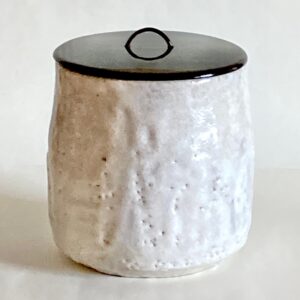
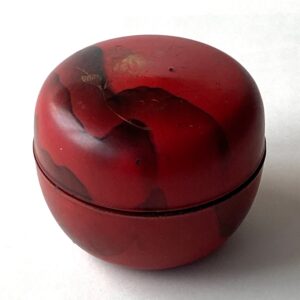
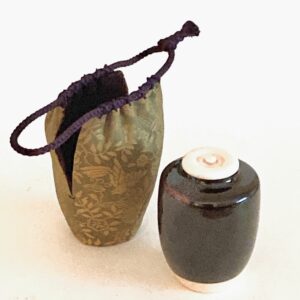
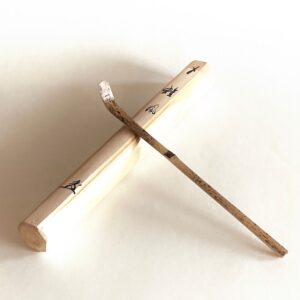
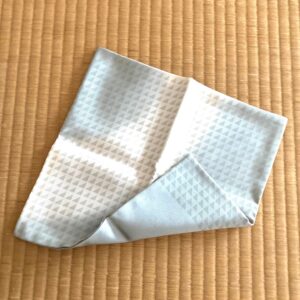
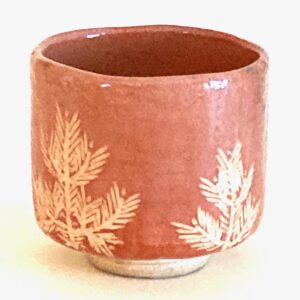
‘Waka-matsu’, 若松, is one of a series of 12 different chawan for each of the months of the year; this bowl was designed for the 12th month. The term ‘waka-matsu’ in this instance refers to the ‘kado-matsu’, 門松, gate-pine, which is a decoration pine, bamboo and ‘plum’ for the posts of an entrance to greet the New Year. An original tradition was to display two pine saplings, with the idea that the saplings, would grow and live to become an evergreen oi-matsu, 老松, aged-pine.
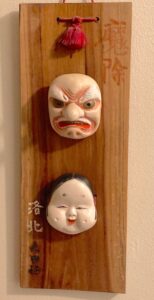
In the maichi-ai, 待合, wait-join, a wooden votive plaque with ceramic masks of Sarutahiko and Amenouzume, with calligraphy in red ma-yoke, 魔除, demon-abolish; a charm against evil spirits used as a talisman or amulet, calligraphy in white Raku-hoku, 洛北, Capital-north, and branded Ō-ta Jin-ja, 大田神社, Great-field God-shrine, Kyōto.
Setsubun is the seasonal division between the harshness of winter and the promise of the abundance of spring as personified by the Oni, 鬼, Demon, and O-ta-fuku, お多福, O-much-fortune. They are later manifestations of Sarutahiko, 猿田彦, Monkey-field-lad, and Ame-no-uzu-me, 天細女命, Heaven’s-slender-woman. These primal deities are revered at various shrines in Japan,including the very early Ō-ta Jin-jja, 大田神社, Great-field God-shrine.
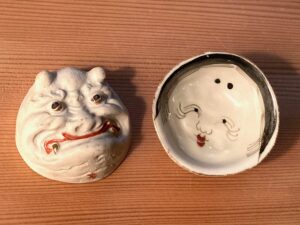
In this presentation, the cup is used as a futa-oki, 蓋置, lid-place, for the kama no futa, 釜の蓋, kettle’s-lid. The form of the oni mask has a prominent chin and a pair of horns, which are similar to the three legs of the trivet go-toku, 五徳, five-virtues. Adhering to Rikyū’s rule, a futaoki with three legs, with one leg as shō-men, 正面, correct-face. When displayed, the cup is upright, and when used as a futaoki, the oni mask is upright. The sake cup manifests the Setsubun expression of purification: ‘Oni wa soto fuku wa uchi’, 鬼は外福は内, Demon is out fortune is in.
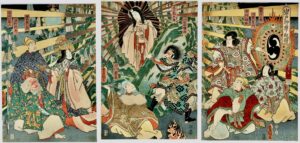
There are many theories as to the origins of this story, including the incursion of Korea into Japan. Also, it is possible that the story developed as a way to explain the absence of the sun. It is found in historical research that total solar eclipses occurred on the 24th day of the 3rd month in 247, and on the 5th day of the 9th month.
In Japan’s rich mythology, it is said that on the banks of the Ama-no-gawa, 天の川, Heaven’s-river, the Milky Way, Ama-terasu, 天照, Heaven-brightener, outraged by the actions of her brother, Su-sa-no-o no Mikoto, 素戔鳴尊, Elementary-remain-cry-noble, concealed herself, komori, 籠, seclude, in the cave called Ame-no-iwa-ya-do, 天の岩屋戸, Heaven-’s-rock-house-door. Yado means a place to stay.
Characters depicted above, from the left are a standing man who holds a ko-tsutsumi, 小鼓, small-drum; seated Saru-ta-hiko, 猿田彦, Monkey-field-lad, holds sacred sakaki, 榊, Cleyera japonica, with cut-paper streamers; Ame-no-uzu-me, 天細女, Heaven’s-narrow-woman, holds a cluster of suzu, 鈴, bells, in her right hand, and a branch of sakaki in her left; Amaterasu with her rays streaming from the open cave; Ta-jika-rō, 手力男, Hand-strength-man, holds back the stone that block the cave entrance; Omoi-kane, 思兼, Think-ahead, sits near the fire he built, and in his right hand holds a tube-lighter, hi-ori-ko, 火折子, fire-fold-of, or he holds a hi-fuki-dake, 火吹竹, fire-blow-bamboo, to stoke the fire; at far right, a man plays the tai-kō, 太鼓, grand-drum; a person holds Amaterasu’s chicken of dawn, identified as ‘long singing’; another musician holds a shō, 笙, bamboo organ-like wind instrument.
Amaterasu emerging from the Ame-no-iwa-ya-do, 天の岩屋戸, Heaven-’s-rock-house-door, holds a hō-ju, 宝珠, treasure-jewel, on her left hand, and a to-tsuka-no–tsurugi, 十拳剣, ten-fist-sword, She wears a hōju on her crown. Ta-jikara-o, 手力男, Hand-strength-male, is depicted holding back the rock door, and Omoi-kane no Kami, 思金神, Think-gold’s God, god of wisdom, is identified with planning to get Amaterasu out of the cave, and bringing a fire to the event. Omoikane no Mikoto has the power to control the eight weather conditions of clear, cloudy, rain, snow, thunder, wind, frost, and fog.
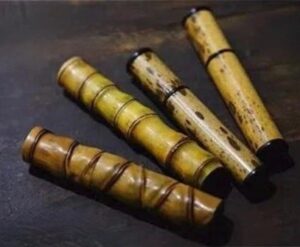
Omoi-kane, 思兼, Think-ahead, has a prominent position in the illustration, together with Amaterasu and Amenouzume. He organized the procedure to get Amaterasu out of the cave. First, he built a fire to light the scene. He did this by using a hi-ori-ko, 火折子, fire-fold-of, which is a kind of lighter. In the illustration above, Omoikane holds a hi-ori-ko in his right hand. Modern hioriko have a battery driven element in lieu of a burning ember.
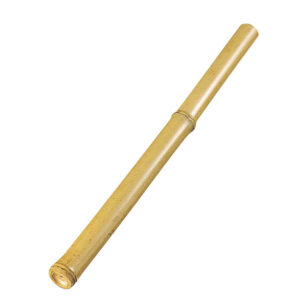
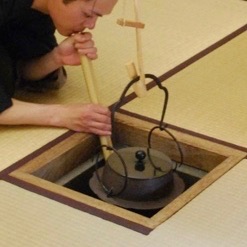
Left: hi-fuki-dake, 火吹竹, fire-blow-bamboo, Rikyū choice L. kyū-sun kyū-bu kane-jaku, 九寸九分曲尺, nine- ‘inch’ nine-divisions bend-span, approximately 11 ¾”. Right: blowing into a hifukidake to provide additional air to stoke the charcoal fire in the ro. The vessel depicted is a cha-han-gama, 茶飯釜, tea-rice-kettle, to cook rice to serve at a cha-ji, 茶事, tea-matter. The guests may also participate in using the hifukidake. One might question why Rikyū chose the measurement of 9.9, which, in Japanese, can be read kuku; 9.9 is 1/10th short of 10. Why not 10?
Perhaps, because of Rikyū’s devout Buddhism, he may have wanted to evoke the Buddhist concept of ku, 苦, suffering. In Buddhism, suffering, Pali: dukkha, Sanskrit: duḥkha, refers to suffering or distress of mind or body. Buddhism is based on the three principles of impermanence, suffering, and non-self. Ku-ku, 苦苦, means a state of suffering from pain. To physically suffer pain, such as cold, hunger, injury, etc. is natural and basic. Following Buddhist precepts, one may overcome the physical and emotional pain. Therefore, it is essential for each of the guests to blow into the fire with the bamboo tube, which the concept of Ne-han, 涅槃, Black soil-tub, Nirvana, in Sanskrit, means ‘blowing out’ ‘extinguished’. The more expedient the fire, the sooner it will become extinguished.
Since ancient times in China, a length of bamboo was stuffed with dried plant fibers, and some phosphorus.
This was lit with a fire to form an ember, and sealed with a cap, and a small air hole in the side to let the ember continue to smolder. When needed, the cover is removed, and by simply blowing across the ember, it ignites some kindling to start a fire. This remarkable device is still made and used to the present. Like many lighters, the hi-ori-ko is available in a myriad of styles and materials, much as the protective covering of the cell phone.
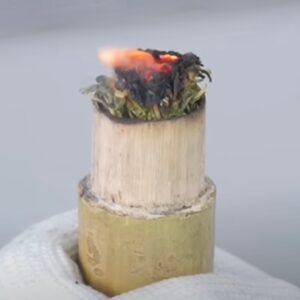
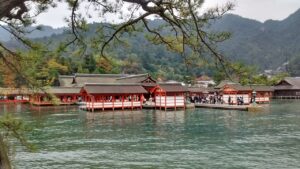
Amaterasu received a sword from her brother, Su-sa-no-o no Mikoto, 素戔嗚尊, Elemental-remain-crying’s noble, which she broke into three pieces. She washed the pieces of the sword in the Ten-shin-me-i, 天真名井, Heaven-true-name-well, chewed them up, and blew out a narrow mist, giving birth to the three Shintō goddesses; Tana-shi-hime, 田心姬, Rice field-heart-princess, Tan-zu-hime, 湍津姬, Rapids-port-princess, and Ichi-ki-shima-hime, 市杵島姬, Market-pestle-island-princess. These three princesses are the principal deities enshrined at the wondrous Itsuku-shima Jin-ja, 厳島神社, Strict-island God-shrine, on Miya-jima, 宮島, Palace-island.
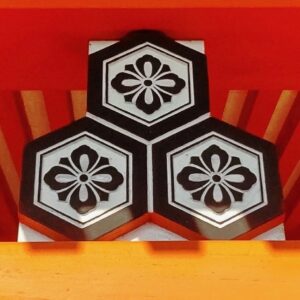
Monyō,文様, letter-motif, crest of Itsukushima Jinja, with three hexagrams representing the three princess goddesses. The central floral motif is believed to be chrysanthemums that are symbolic of the omnipresence. The hexagram suggests the shell of the turtle, which is a creature of the sea that is ruled by their ‘father’, Susanoo. This crest is stamped on the chawan pictured below.
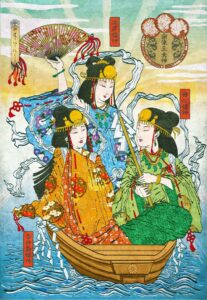
The three princess goddess ‘daughters’ of Amaterasu created by transmuting the sword of Susanoo are known by various names. Regardless of the name, however, each ends with either [no] kami, の神, god, or [no] mikoto, 命, fate; i.e., Ta-gi-tsu-hime-no-kami, 湍津姫神, or Ta-gi-tsu-hime-no-mikoto, 湍津姫命. All three deities are associated with different aspects of water, as they are technically the offspring of Susanoo, the god of the sea. Frequently, they are depicted as above in a boat on the sea.
Ta-kiri-hime, 田心姫, Field-heart-princess, wears a green garment, and holds with both hands a Shintō go-hei, 御幣, hon.-staff with paper pendants. She is identified with mist.
Ichi-ki-shima-hime, 市杵島姫, Town-pestle-island-princess, wears an orange garment, her hands are concealed except for two fingertips. She is identified with the sea.
Ta-gi-tsu-hime, 湍津姫, Rapids-port-princess, wearing a blue garment, and holds an ōgi, 扇, (folding)fan, in her right hand. She is identified with rushing water.
The number 3 has great significance in Japanese culture. The kanji for 3 is 三, san, sui, zui, mitsu, mi, zō, etc. It has a homonym with the Kanji for water, mizu, 水. Also, in Japanese Kanji it is the radical, 氵, san-zui-hen, 三水偏, three (brush stroke)-water-(left) side. Curiously, three is manifest in the triangle, san-kaku, 三角, three-corner, which is symbolic of Fire. The same identity is also found in English in words such as pyrotechnics, Greek words pyr (fire) and tekhnikos (made by art), and pyramid, from the Greek word pyramidos, has been translated as ‘fire in the ‘middle’.
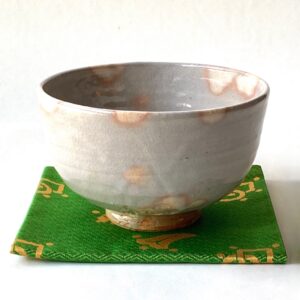
Cha-wan, 茶碗; tea-bowl; gray and pink glazed ceramic, O-suna yaki, お砂焼, Hon.-sand fired, by Kawa–hara Tō–sai, 川原陶斎, River-field Ceramic-abstain, Miya-jima–guchi, 宮島口, Palace-island-mouth. Made for Itsuku-shima Jin-ja, 厳島神社, Strick-island God-shrine. The color variation is made by grains of sand from the beach of the Shrine. Ko-buku-sa, 古帛紗, old-cloth-gauze, green silk fabric square with gold thread circle and square motifs, made for the acknowledgement of Za-bō-sai, 坐忘斎, Sit-forget-abstain, as Waka-Sō-shō, 若宗匠, Young Sect-worker, to become XVI Iemoto of Urasenke, at Hei-an Jin-gū, Kyōto. Generations of Urasenke Iemoto have presented Ken-cha, 献茶, Offering-tea, at this sacred place.
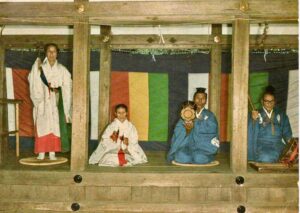
Dancer and musicians offering Kagura, 神楽, God-music, at Ō-ta Jin-ja, 大田神社, Great-ricefield God-shrine, dedicated to Amenouzume, in Kyōto. The dancer emulates the dance of Uzume before the heavenly cave of Amaterasu. Ōta Jinja has the oldest Kagura in Japan, and Kyōto’s gei-sha, 芸者, art-ist, mai-ko, 舞子, dance-child, and other artists worship at this shrine to give thanks and receive spiritual guidance.
Ōta Jinja is an auxiliary branch of Kami-ga-mo Jin-ja, 上加茂神社, Upper-(ka)-luxuriant God-shrine, was founded in 678, although records recognize its possible existence before Kamigamo Jinja. Note the participants are located on en-za, 円座, circular-seats. Many years ago, I offered Chanoyu at this shrine on Setsubun.
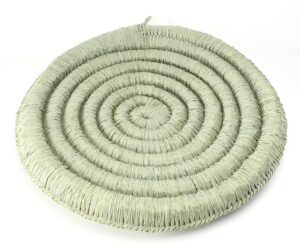
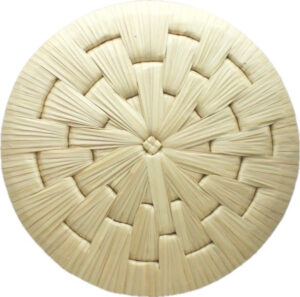
En-za, 円座, round-seat, straw, seven turns, diam. 18 sun kane-jaku, made for Shintō shrines and imperial and aristocratic settings. According to Shintō, the universe was created in seven epochs. The mat is for sitting in sei-za, 正座, correct-seat, or sei-za, 静座, quiet-seat, sitting calmly and quietly (i.e. in order to meditate), on the floor, and a place for Shintō kagura, 神楽, god-music, in which the dancer sits and stands turning towards various directions shaking the suzu, 鈴, bells, a cluster of bells with a handle. In one of the dances, the dancer spins around seven times in one location. In Chanoyu, there are enza provided at the koshi-kake machi-ai, 腰掛待合, bottom-hand wait-gather. The preferred type has 20 radiating strips of suge, 菅, sedge, Cyperaceae spp., esp. members of genus Carex; diam. 8 sun kujira-jaku. The size of the Chanoyu five-circle enza is approximately equal to the five inner circles of the 7 circle enza.
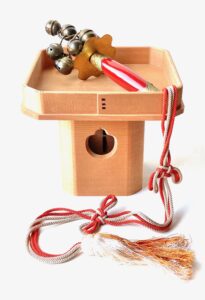
Ka-gura suzu, 神楽鈴, God-music bells, cluster of suzu on a spiral wire with wooden handle and red and white cord streamer. The number of bells in the cluster varies, although three rings is the standard. The pictured suzu has five bells on the lower ring, three on the middle ring, and two on the upper ring: ten bells in total. The bells are separated from the handle by a flat, six-lobed tsuba, 鍔, guard. The cluster of bells is displayed on a plain wood san-bō, 三方, three-directions, for Shintō offerings. In Christian settings ten bells are rung for a variety of occasions such as major church observances, consecration, and for civic celebrations such as weddings. Specifically, sanctus bells are used to express joy and gratitude.
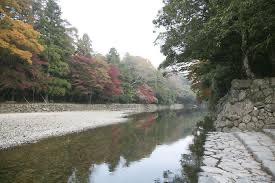
The Shintō kagura has its origins in the dance performed by Uzume before the Amenoiwato. The word suzu comes from the sound of the jingling bells. The supreme Shintō shrine of I-se Jin-gū, 伊勢神宮, That-strength God-palace, is situated by the I-su-su Gawa, 五十鈴川, Five-ten-bells River, where worshippers purify hands and mouth before approaching the shrines. This water purification is found in the roji garden of Chanoyu. The water flowing over the stones in the river makes a sound like the suzu bell cluster. The bell cluster is displayed during the New Year festivities.
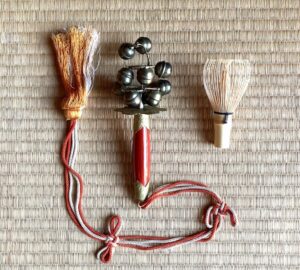
The bell cluster and handle length is 5 sun kane-jaku: the bell cluster length is 2 sun kane-jaku, the handle length is 3 sun kane-jaku. The doubled cord length is 2 shaku kane-jaku.
The chasen length is 3 sun kujira-jaku. The measurement of the tines from the thread is 18 bu kujira-jaku, and the measurement of the handle from the thread is 12 bu kujira-jaku. The ratio between 12 and 18 is 6.666 to infinity.
Both the bell cluster and chasen are moved in their function. The bell cluster is held upright and twisted quickly to ring the bells. The whisk held downward and moved briskly far and near. There are moments when whisking the tea, that the whisk is twisted right and left. Before making tea, the whisk is rinsed quickly in hot or cold water, and examined, cha-sen tōshi, 茶筅通し, tea-whisk through, the sound of ‘sara-sara’ is made. When whisking thin tea, the rapid movement of the chasen also makes the sound ‘sara-sara’. This sound is likened to the sound of the wind blowing through reeds along a river. One might recall the sound of reeds shaken in front of the cave of the hidden Amaterasu.
Before worshipping at Ise Shrine of Amaterasu, one purifies oneself in the nearby waters of the I-suzu-gawa, 五十鈴川, Five-ten-bells river. It is likely that the bell sound of suzu may be likened to the sound of the river water splashing over the river stones. A similar rushing sound is made with the Shintō gohei waved in purification by Ta-kiri-hime.
Guests at a Tea gathering wait in the in the ro-ji, 露地, dew-ground, garden. At the nearby tsukubai, 蹲踞, crouch-down, purification area, the host refreshes the water in the chō-zu-bachi, 手水鉢, hand-water-bowl. Although the guests may not see the host pouring water from a bucket into the chōzu-bachi, it is important for the guests to hear the sound of the water pouring. The host, after purifying hands and mouth, goes to welcome the guests, and opens the door of the chū-mon, 中門, middle-gate, that separates the soto-ro-ji, 外露地, outer-dew-ground, and the uchi–ro-ji, 内路地, inner-dew-ground. After a silent bow of greeting, the guests proceed to the tsukubai, ideally crossing a stream of water that is suggestive of the Amanogawa. The guests purify the hands and mouth before entering the Tearoom. Similar acts of purification are enacted before entering a place of worship and reverence. A stone in the roji called a seki-mori ishi, 関守石, barrier-guard stone, stops passage that leads away from the path to the Chashitsu.
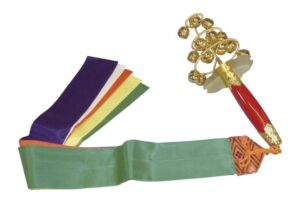
The more familiar attachment to the cluster of bells is a go-shiki-ginu, 五色絹, five-color-silk, which is composed of five fabric strips of the go-shiki, 五色, five-colors: one of the standard length of streamers is 3 shaku kane-jaku. The number five has far-reaching symbolism in Japanese culture, such as the Go-gyō, 五行, Five-transitions, physical elements, and the Go-rin, 五輪, Five-rings, principles. From a Buddhist and/ or Taoist perspective, taken together these elements and principles are the building blocks of life. In Japanese, the Kanji for life is the number 18. In Japanese the Kanji for 18, jū-hachi, 十八, ten-eight, can be written as one Kanji, moku, 木, tree, which is symbolic of ‘life’.
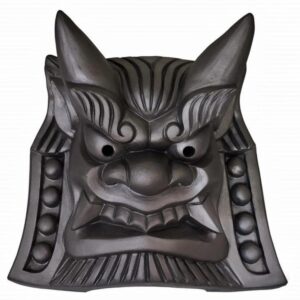
In Japan in 2025, The lunar New Year and Setsubun and Risshun, the separation of winter and summer, occur very close together. In a way, the proximity of these events can be seen as a joining of lunar and solar calendars. The yo-jō-han cha-shitsu, 四畳半茶室, four-mat-half tea-room, events of the lunar and solar calendars can be ascertained.
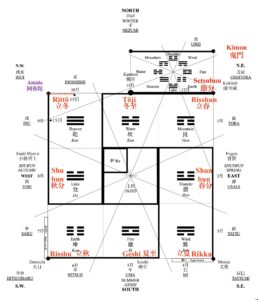
Diagram of a yo-jō-han cha-shitsu, 四畳半茶室, four-mat-half tea-room, identifying solar and lunar calendar events, and influences of the Eki-kyō, I Ching, 易経, Change sutra, and Buddhist deities. In the ideal yojōhan, Risshun is located northeast corner of the room, which is the location of the corner hashira, 柱, post. The post also ends on the last day of the 12th lunar month, and begins the first day of the first lunar month. The post is also identified with the ki-mon, 鬼門, demon-gate, which guards against the harsh northeast winds.
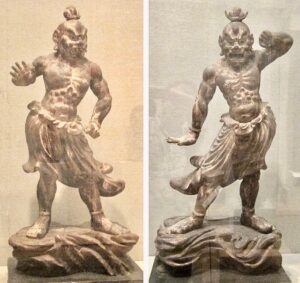
The northeast direction is the source of the harsh winds, and is identified as Ki-mon, 鬼門, Demon-gate. It is possible that the ‘demon’, oni, 鬼, is actually the guardian of the northeast, who is like the pair of fierce-looking Ni-ō, 仁王, Benevolent-kings, who guard the entrances to temples and shrines. At an entrance, the Niō are observed from right to left: the Niō on the right has his mouth open, A-gyō, あ行, Ah-transition, the Niō on the left has his mouth closed N-gyō, ん行, N-transition. Together, the open and closed mouths represent the sounds of AUM, the sound that can lead to enlightenment. Both are wind deities, as it requires wind to utter sounds. It is believed by some authorities that the Niō on the right is the origin of the ‘demon’ of the Kimon. It is curious that the word oni, demon, is the reverse of niō, Buddhist guardian.
The character of the Setsubun goddess, Amenouzume, is manifest in various forms including the very popular O-ta-fuku, お多福, O-much-fortune. Over the centuries, Otafuku has been coupled with different male characters, principally, the often ribald Hyo-ttoko, 火男, Fire-man, as well as the Shintō deity, Saru-ta Hiko, 猿田彦, Monkey-ricefield-lad, and the Zen Buddhism founder Daru-ma, 達磨, Attain-polish. Amenouzume is recorded as being the spouse of Saruta, so that her music and dance is called saru-gaku, 猿楽, monkey-music, which is a term used for much of Shintō music.
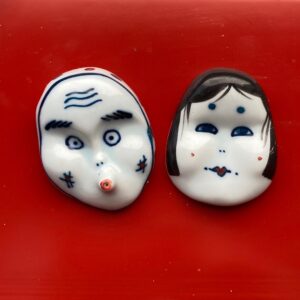
Until recently, I believed that Hyotoko, 火男, Fireman, was mis-named, as his contorted facial expression and puckered mouth alluded to his role of stoking a fire by blowing into a bamboo tube, hi-fuki-dake, 火吹竹, fire-blow-bamboo, and therefore could be identified as a Wind-man. The procedure of stoking the fire is followed by the host and guests at a Chaji when cooking a kettle of rice placed over the fire in the hearth. Blowing through a bamboo tube to cook rice is an act of creation.
Setsubun is a rite to coax Amaterasu from her seclusion in the cave of heaven and thus, in some Japanese traditions, marks the change of spirits of Winter to Spring. Among the principal participants were Amenouzume, who danced and chanted to make the gods amused, Tajikarao, who held back the cave door/stone, and Omoi-kane, 思兼, Think-ahead, who organized the event, and brought a fire to light the darkened scene. It became clear to me that Omoikane was the source of the identity of Hyottoko, who tends the fire. In addition, Hyotoko’s relationship with Otafuku, mirrors the association between Omoikane and Amenouzume.
For further study, see also: Lunar New Year and Kagami Mochi, New Year Collection, and Setsubun and Otafuku Collection
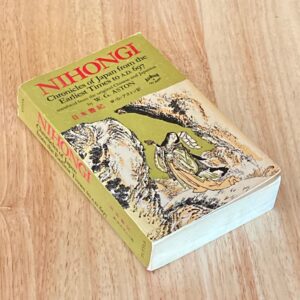
The importance of the rite of Amenouzume to coax Amaterasu out of the cave of heaven is such that it is depicted on the cover of the Tuttle paperback version of the Nihongi, Chronicles of Japan from the Earliest Times to A.D. 697, [completed in 720 CE] translated and interpreted by W. G. Aston, 1972. It is truly invaluable resource for learning about Japanese culture. Ni-hon-gi, 日本紀, Sun-origin-record: Nihon and Nippon mean Japan, which is located in the east from the vantage of China, Chū-goku, 中国, Middle-country. Other ancient Japanese historical writings include the Ko-ji-ki, 古事記, Old-matters-account, which was compiled in 712 CE.

